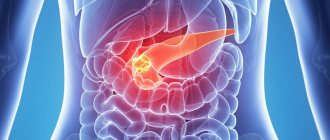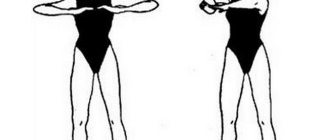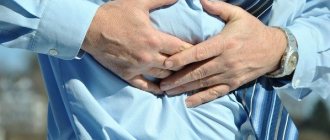Problems with the functioning of the gallbladder and liver occur quite often. There are many reasons why the outflow of bile from the biliary tract is disrupted.
This problem requires high-quality and complete treatment. To date, many medical devices and techniques have been developed to optimize the functionality of the gallbladder. One of these techniques includes specially designed exercises for the gallbladder during bile stagnation , which serve to improve the physical qualities of the organs. Today, many factors can cause stagnation of bile in the bile excretory organs: stress, low physical activity, bad habits, poor diet.
The need for gymnastics when the gallbladder is bent
In adults, excesses most often occur with cholelithiasis, cholecystitis and other gallbladder diseases.
Gymnastics for the gallbladder allows you to eliminate the symptoms of these diseases and performs a number of important functions:
- elimination of pain and heaviness that occurs after bending;
- decreased muscle tone in the gallbladder and the body as a whole;
- increased blood supply to the cells and tissues of the abdominal cavity;
- massage of the liver and gallbladder;
- strengthening metabolic functions;
- improvement of the condition of all gastrointestinal organs;
- removal of excess enzyme from the liver and ducts.
Many people wonder whether it is possible to correct a kink in the gallbladder with physical therapy? The answer to this question depends on the stage of the disease and the degree of inflection, which largely determines the course of treatment.
Subscribe to our INSTAGRAM account!
Undoubtedly, light, specially selected physical therapy will be beneficial and can help optimize the functioning of the biliary organs and help prevent gallstones. However, these manipulations should be performed under the strict supervision of a doctor and regularly.
Therapeutic physical training for cholelithiasis (GSD)
Many adults know about such a disease as gallstone disease and have asked questions such as: what are the causes of gallstone disease, what are the symptoms, how to treat this disease. In this article I will discuss all of the above issues. At the beginning of the article, I focused on age, because according to statistics, people over forty-five years of age and mostly women suffer from this disease.
Gallstone disease is a disease in which stones form in the gallbladder and bile ducts, due to metabolic disorders in the components of bile. This disease can lead to complications if not treated promptly.
Causes of cholelithiasis
The following factors can lead to the onset of gallstone disease:
- stagnation of bile in the gallbladder;
- metabolic disorders, therefore the concentration of salts in bile increases;
- overeating, fasting, irregular eating;
- a sedentary lifestyle that leads to excess body weight (obesity);
- pregnancy;
- pancreatic diseases;
Symptoms
Basically, the disease does not cause any symptoms, but the first signs may become apparent after 5-10 years at most, and may even be painless. Why so long? Because the stone comes out of the bladder into the bile ducts and clogs them, then the following symptoms begin to appear:
- abdominal pain, which can reach a paroxysmal form, lasting from several minutes to 2-3 days;
- spread of pain to the back or to the right shoulder blade, right shoulder, interscapular area;
- nausea and vomiting;
- heaviness in the stomach after eating;
- heartburn;
- bitterness in the mouth;
Let's look at what complications cholelithiasis can lead to if not treated promptly:
- acute cholecystitis;
- cholangitis;
- acute pancreatitis;
- obstructive jaundice;
- gallbladder perforation;
- peritonitis.
Objectives of exercise therapy for gallstone disease
Many people know that therapeutic physical culture plays an important role in almost all diseases, and in case of cholelithiasis it has a beneficial effect and sets itself the following tasks:
- Lead to improved metabolism.
- Improved therapeutic effect.
- Reduction of stones in the gall bladder and ducts.
- Elimination of spasmodic phenomena in the gallbladder and ducts.
- Increased blood circulation in the abdominal organs.
- Maintaining the flow of bile in the gallbladder.
- Eliminate complications.
- Adaptation of the body to physical activity.
- Retains the abdominal organs by strengthening the muscles in the abdomen and back.
- Improvement of the nervous system.
There are some contraindications in which it is strictly forbidden to engage in exercise therapy and any other physical activity, for example: during an exacerbation, at a high temperature, with an enlarged liver, with pain, and more. Before moving on to a set of exercises, you need to remember a few rules that you must follow always and everywhere:
- Exercise regularly, don't stop training. You should exercise once a day, for 10-15 minutes.
- Always increase the load or training time. This will help your body adapt to physical activity faster.
- Perform the exercises diligently to get maximum benefit from the exercises.
- If you feel pain or fatigue while performing, stop immediately.
- Always ventilate the room in which you exercise before performing exercises.
- Follow the diet your doctor prescribed for you.
- Take food in small portions, but 5-6 times a day.
- Try not to eat fried and fatty foods, cook your own meals at home, and try not to overdo it with salt.
- Eat food slowly, try to chew everything. Do not eat 3 hours before bedtime.
- Along with a set of exercises, massage your abdomen, or take a massage course.
- Start your exercise an hour after eating.
A set of exercises for cholelithiasis
I divided all the exercises into 3 groups: introductory, main, final. Let's move on to a set of exercises for therapeutic physical culture:
1. Introductory:
- Walking in a circle on your toes, 30-60 seconds. The pace is slow.
- Walking in a circle, but with high knees. Duration 35-45 seconds.
- Starting position - hands on the belt. Walking in a circle, combine with body movements to the right/left and forward/backward. The pace is slow. Repeat for 30-40 seconds.
- Starting position - stand straight, feet shoulder-width apart, hands on your waist, head looking straight. Tilt your head in different directions. Repeat 5-7 times.
- Starting position: stand straight, feet shoulder-width apart. The arms are raised to the sides to shoulder level. We make small movements with our hands up and down. We lower and raise our arms no more than 10-15 cm. These movements resemble oscillations. Perform 10 such swings.
- Starting position - stand straight, place your feet shoulder-width apart, lower your arms along your body. Bend your knees and perform a squat. At the same time, move your pelvis back. The knees should not extend beyond the line of the toes, and the feet should not leave the floor. Repeat 4-6 times. Watch your breathing.
2. Basic:
- Starting position - sit on a chair, put your hands on your belt. When you inhale, move your arms back, and when you exhale, on the contrary, move your arms forward. The pace is slow. Repeat this exercise 6-8 times.
- Starting position - sit on a chair, lower your arms and relax. Start breathing with your stomach, also called diaphragmatic breathing. Repeat 8-10 times. The pace is slow.
- Starting position - lie on your back, arms along your body. Pull your knees towards your stomach, bending both legs, do this all while inhaling. As you exhale, return to the starting position. Repeat 4-6 times. The pace is slow. Watch your breathing.
- The starting position is the same. Simulate riding a bike while lying down. Repeat this movement 8-10 times.
- Starting position - lie on your side (no matter which side), arms along your body. As you inhale, lift your leg up, and as you exhale, release it. Repeat on one side 6 times, then switch to the other side and continue doing the same.
- The starting position is the same. Take your legs back - bend forward, pull your knee towards your stomach. Repeat 4-6 times.
3. Final:
- Starting position: stand with your hands on your hips. Take a long, moderate deep breath, while drawing in your stomach without holding, exhale clearly and with all your might. Repeat this breathing exercise 6-8 times.
- Starting position: stand with your hands on your waist. Make rotational movements with your torso. Repeat 6-8 times on each side.
- Starting position - stand. Slow walking in a circle for 30-60 seconds.
- Starting position - stand with your arms along your body. Stand up, stretch your arms towards the ceiling as you inhale and slowly rise onto your toes, and as you exhale, lower yourself onto your heels and lower your arms. Repeat 8-10 times.
We examined a small part of the exercise therapy complex for cholelithiasis. I can say a lot about the fact that exercise therapy is the main part of treatment, but you should know that you need to avoid shaking, sudden movements, jumping, and carrying heavy objects. Your doctor should create a set of exercises for you, so do not self-medicate, as the exercises listed here may not be suitable for you. Contact your doctor promptly and stay healthy.
Exercises to remove bile from the gallbladder canal
Exercises for the gallbladder help relieve the organ and help bile pass into the intestines. Regular removal of bile from the gallbladder is an important part of the functioning of the gallbladder organs.
Therapeutic gymnastics should consist of several stages and be carried out after consultation with a doctor.
Today, a large number of videos and films have been shot with developed complexes to improve the functioning of various organs and tissues. It is important to understand that these complexes are not suitable for all patients, since each body is unique and there may be a number of contraindications for a particular workout.
Gymnastics for bending the gallbladder should be a complex:
- liver and gallbladder massage,
- physical exercise,
- exercise therapy complexes,
- beneficial for the liver and helping with stones in the gallbladder.
To create normal conditions for the functioning of the gallbladder and better outflow of enzymes, doctors recommend performing therapeutic exercises such as walking short distances, slow dancing, swimming, skiing in the winter and short ice skating.
This exercise will help increase blood flow to all organs and tissues, including the bile ducts.
“bicycle” (rotating the legs in a lying position in a circular motion), “scissors” (crossing movements with straightened lower limbs), as well as have beneficial properties for removing bile .
You can do right angle knee raises - this can be done in any position.
It is important to monitor your breathing at the same time.
These exercises do not have any consequences for a person, they can be performed in any condition and have no direct contraindications.
Exercises can be performed in a position that is comfortable for the patient. It is important not to overexert yourself or make sudden movements, which can cause increased pain and complications.
For stones and bile ducts, exercise therapy complexes should include not only useful exercises for bile stagnation, but also those that are not contraindicated for these diseases.
Standing exercises for the gallbladder
Performing exercises in a standing position is possible only with stable coordination of the patient’s movements. It is important to have a constant point of support close to where tasks are performed.
Exercises performed by the patient while standing are optimal not only for the outflow of bile, but are also very useful for bending the gallbladder, since in this position the gallbladder is most likely to assume a physiological position - this allows you to quickly remove the bend of the gallbladder and restore blood flow in the organ.
These tasks are also indicated for signs of bile stagnation.
1. Turn the body left and right with a smooth increase in the depth of rotation to the maximum level of the patient. It is important to monitor your posture and breathe correctly during the task. Repeat the exercise 7-10 times.
2. Walking with the knee joint elevated when stepping - do for 1-2 minutes.
3. Perform “rolling” from heel to toe, keep your hands on your belt at this time, and when changing position, alternately exhale and inhale. Within 30 seconds.
4. Rotation of the body, first in one direction, then vice versa - 5-10 times for each half of the body.
5. Slowly bend the body forward and backward for 30 seconds.
6. Stand up straight, legs slightly apart. Extend your arms in different directions, while placing a small object or ball in one hand. Inhale and bring your palms together, while transferring the ball from one hand to the other, and as you exhale, move it apart again. Do 10-15 times.
7. Do slow, shallow squats 10-15 times.
8. Legs are spread apart, while inhaling, we lift the extended upper limbs upward, and while exhaling, we lower them down. Do 10-15 times.
It is recommended to do physical exercise regularly, preferably in the morning, so that the body is recharged with energy and tone. Before doing the tasks, consult your doctor about the possibility of doing them.
Liver Exercises: Actively Protect and Improve Function of the Vital Organ
The liver is a vital organ that is the natural filter of our body. Due to poor nutrition, a sedentary lifestyle, drinking alcohol and smoking, the liver ceases to cope with its functions, which can lead to the development of diseases of this organ. Special exercises for the liver can provide significant assistance in preventing liver diseases or alleviating existing ones.
- This gymnastics should be performed in the first half of the day, in a well-ventilated area, repeating each exercise 4-5 times. Lying on your back, place your arms along your torso and raise your legs. Pedal an imaginary bicycle for 30-60 seconds.
- Lying on your left side, simultaneously raise your right arm and right leg, hold for a couple of seconds and return to the starting position.
- While lying on your back, place your hands under your buttocks, palms down, then bring your legs together, raising them above the floor by about 8 cm. Next, cross your legs, imitating “scissors.”
- Lying on your stomach, arch your back slightly and “swim” breaststroke for 30 seconds.
- Get on all fours, sit on your heels, staying in this position for 1-2 minutes.
- Starting in a standing position, perform 15-20 squats with your hands on your waist.
- From a standing position, perform 15-20 bends forward and to the right, trying to touch your right knee with your forehead.
- Perform two-legged jumps about 10 cm in height while standing still.
Massage exercises for the liver.
The most optimal exercises for the liver are performed in positions lying on the right side or standing on all fours, since this is the position of the body that minimally loads the liver and promotes the outflow of bile.
First, a warm-up exercise is performed for 2 minutes, effectively launching the entire circulatory system, alternately raising your body on the toe of your right or left leg, while simultaneously tilting your head in the opposite direction.
Then, lying on your back, raise your right arm up while bending your left leg so that your foot slides along the floor. While performing this exercise, you should inhale through your nose, and when returning to the starting position, exhale through your mouth.
While lying on your left side, bend your left leg and raise your left arm up (in a straight position). Next, raising your right arm, inhale and press your bent right leg with your right knee to your chest.
Get on all fours, raise your head and inhale. Slowly move your right leg into a position between your hands, while your leg should slide along the floor. Next, do the same with your left leg.
Such exercises effectively eliminate congestion in the liver and gall bladder, improve metabolic processes in the liver and stimulate the formation of bile.
Before you begin performing this exercise for the liver, you should consult with your doctor, who will help you adjust the load based on the severity of the disease and the general condition of the body. An absolute contraindication for performing physical activity is a period of exacerbation of cholelithiasis or cholecystitis.
It should be remembered that maintaining liver health is carried out not only with the help of gymnastics, but also by giving up bad habits, proper nutrition and a healthy lifestyle.
Lying exercises for the gallbladder
To remove stagnation of bile, physical exercise performed while lying down, when the body is in the most relaxed state, is also useful. This helps to increase and improve the blood supply to the tissues and reduce the tone in them.
1. Lying on your back, upper limbs parallel to the body, bend your lower limbs, press them tightly to your chest and stay in this position for a while, then slowly relax and lower your limbs.
2. The starting position is the same - lean your lower limbs against your stomach - first one, then the other, and try not to move your arms and body.
3. Position – lie on your back, knees bent, heels pressed firmly to the floor. Using sliding movements along the floor, straighten your legs to the surface, then lift them again. Perform 10-15 times.
4. Lie on your back with your knees tucked into your chest. Straighten your legs, without lifting your body, up so that your straight legs are perpendicular to the floor 10-15 times.
5. For the next task, you need to lie on your side, legs straight. Smoothly lift the limb up to the maximum level, then lower it. Do 5-10 times, then lie on the other side and repeat.
6. Lying on your stomach, arms straight above your head, lift your straight limbs based on your capabilities. 5-10 times.
7. On your stomach, perform a movement similar to breaststroke swimming for 15-20 seconds.
To carry out tasks, the patient takes a lying position on a firm, but not hard surface (for this it is better to use a special mat or lay a thick blanket on the floor).
Exercises against bile stagnation and improve digestion
During the New Year holidays, we often move less, and often overeat. As a result, digestion may deteriorate and bile stagnation occurs, which affects well-being and complexion. The situation is aggravated by the consumption of alcohol and fatty foods.
A few simple exercises that can be performed at home will help avoid stagnation of bile, and therefore many unpleasant symptoms - heaviness after eating, nausea, cramps, pain in the right side, hypochondrium, constipation, chronic fatigue, as well as the development of cholecystitis - inflammation of the gallbladder and cholelithiasis .
Stagnation of bile also affects the appearance - dryness, sagging skin, acne, dull complexion, and in especially severe cases - a yellowish tint, yellowing, redness or clouding of the whites of the eyes.
To help the functioning of our liver and gallbladder, experts recommend first performing exercises aimed at stretching the spine, which will help normalize the flow of bile, improve the nervous regulation of the gallbladder, and prevent inflammation (cholecystitis) and the formation of stones.
Of course, it is advisable to do exercises not on a full stomach, at least two hours after eating.
So, let's open the ducts! Gymnastics to promote bile flow
You can start a set of exercises with breathing practice. It should be noted that breathing exercises, so popular in yoga, are primarily aimed at improving the functioning of internal organs, liver, and intestines.
Stand with your feet together. Lean your body forward, place your palms on your knees. Take a deep breath, then exhale all the air from your lungs. Hold your breath and pull your stomach under your ribs. Without inhaling, make 5-6 movements with the front wall of the abdomen, either pushing the navel forward or pulling it towards the spine. Then relax your stomach and inhale.
Simple walking in place
Starting position – standing, legs together.
Walking with high hips. The tempo is average, transition to fast is possible. After resting and relaxing your muscles, walk with a “ski” step, on tiptoes, on your heels.
Exercises for the spine against bile stagnation
Tilts and rotations
Starting position – standing, feet shoulder-width apart.
Bend your torso forward, bend in combination with rotating your torso, slowly, and with caution, especially if you have gallstones.
Twisting (twisting) of the spine
Any yoga asanas associated with twisting the spine (twisting in yoga) are beneficial for the liver.
The simplest option. Sit cross-legged with your knees bent and your shins crossed. Place your palms on your knees. Then twist your body to the right, placing your left hand on your right knee and placing your right palm on the mat behind you. Repeat the movement in the opposite direction.
Another option. We sit on the floor, legs straightened. Bend your right leg at the knee and step over your left. Place the foot on the outside of the left knee. Bend the left leg at the knee and bring the left heel closer to the right buttock. We move our left hand under the right thigh and clasp it around the wrist or fingers of the right hand.
Ab exercises
Lying on your back, simple lifts of the body to the shoulder blades. Perfectly cleanses the liver. The head lies on the hands, but there is no need to pull the head with the hands; lifting is only due to the muscles of the upper abs.
Next we move on to the intestines. Lying on your back, you need to raise and lower your legs. Thanks to this exercise, the spine is stretched, internal organs are massaged, and the abdominal wall is strengthened. This is the prevention of stagnation in the intestines and prolapse of internal organs. It is best to perform from 20 to 50 times a day.
It is also useful to regularly perform abdominal exercises such as cycling and scissors.
Boat, aka “locust”
Starting position: lying on your stomach.
Place your hands shoulder-width apart. Legs - the width of the pelvic joints. As you inhale, slowly raise your legs and arms up. Palms should face each other. Actively push your toes away from you. We look at the floor. We stretch the crown of our head forward. Due to this, the neck muscles are stretched.
Next, move the shoulders as far away from the ears as possible (increase the distance between the shoulders and ears as much as possible). Lean on your stomach and with each inhalation try to lift your legs and arms up as high as possible. We lower our arms and legs down with an exhalation. Place your head on either side. Move your pelvis slightly to relax the lower back area.
Bow pose
Let's lie on our stomachs. Place your feet hip-width apart. Legs are bent at the knees. Grasp the outside of their ankles and press their thumbs together. Tighten your gluteal muscles and lift your chest and legs up as you inhale. We look straight ahead. We also keep our neck straight.
Scissors
Starting position – lying on your stomach
. We do the “boat” again, and then cross movements with our feet – “scissors”. Then try repeating the breaststroke movements, slowly inhaling as you lift your head and exhaling into the imaginary “water.”
On a note. exercises on the abdominal muscles are useful against bile stagnation .
Lying on your side
Starting position – lying on your left side.
With your left arm stretched up under your head, lift your right leg up to a right angle, and stretch your right arm toward the ceiling. Make rotational movements with your right leg clockwise and counterclockwise.
The duration of classes is approximately 20–30 minutes, the number of repetitions is from 4 to 10, depending on how you feel. Before class, you can lie down on a mat on the floor for a few minutes.
Exercises while sitting on a chair
Let's also start with a diaphragmatic breathing exercise, which has a beneficial effect on the liver. Sit on a chair and straighten your back. The right hand should be placed on the chest and the left hand on the stomach. Inhale slowly with your stomach - it will stick out forward, you will feel it with your left hand. Continue inhaling through your chest - control this with your right hand. Continue to inhale diaphragmatically, contracting your belly. At the same time, the diaphragm rises. Finish inhaling with your chest. Hold your breath and exhale fully and loudly through your mouth. Breath holding can be gradually increased.
We continue while sitting on a chair.
Hands on the belt, feet shoulder-width apart. Turns the body to the right and left. Then tilt the body to the right and left, first stopping in the center, then pendulum-like.
Hands on the belt, feet shoulder-width apart. Pull your elbows back, inhale. Lean forward, trying to reach the floor with your hands, exhale.
Arms to the sides, palms forward, legs together, inhale. Grasping your knee, pull it towards your stomach, exhale. Same thing with the other leg. Pull both knees towards your stomach, exhale.
Weight correction using kinesitherapy
The Kazan Center for Kinesitherapy and Applied Kinesiology conducts special classes on correcting weight, posture and muscle mass.
Read more: How to safely lose weight and tone muscles?
Specialist consultation is required.
Doctor’s consultation + diagnostics using applied kinesiology – 1000 rubles.
Call, write! Tel.: (843) 570-55-25 , WhatsApp: 79655968085 or VKontakte group .
Even more useful articles in Yandex Zen:
Follow us on Instagram (photos and videos from classes):
Don't miss out on the fun! Subscribe to our news:
Subscribe to news from the Kazan Kinesitherapy Center
Center promotions, therapeutic exercises and useful tips from our specialists on how to independently maintain the health of your joints and spine without medications
Similar articles:
How to strengthen the neck extensor muscles. Exercises at home
Fitness at home. Sets of exercises during self-isolation
Calf exercises for beautiful legs, prevention of joint pain and varicose veins
Exercises for biliary dyskinesia
Exercises for biliary dyskinesia are indicated both during the period of remission and during the initial manifestations of the disease, when there are no sharp manifestations of pain and severe disruption of organ function.
Gymnastics for biliary dyskinesia helps eliminate biliary sludge in the gallbladder and helps reduce attacks during the disease.
Breathing exercises
Breathing exercises are the basis of the correct and most effective way of training, it allows you to increase blood flow in cells and tissues. To do this, it is recommended that a person:
1. Take a comfortable position, relax, stretch your arms forward and up, take a deep smooth breath, then slowly take the starting position, exhaling - 5-7 repetitions are recommended. If you feel dizzy or have blurred vision, you must stop the task.
2. Inflate your stomach, hold your breath, then slowly relax and exhale.
3. While lying on your back, spread your arms in different directions, then raise your arms perpendicular to the body and take a deep breath, and when lowering, exhale slowly.
4. Position - standing, hands on the belt. Move your body in different directions, breathing freely.
5. The position is the same, hands on the belt. Raise your shoulders and head up - inhale, lower your shoulders and head, then exhale.
Gallbladder massage
Gallbladder massage is one of the key points in exercise therapy for gallbladder diseases. It helps strengthen the motility of organs and improve blood supply to their cells.
There are a number of contraindications for massage that limit the circle of people who can benefit from this therapeutic effect:
- The period of acute manifestations of diseases of the abdominal organs.
- Purulent and inflammatory pathologies of the gastrointestinal tract and peritoneum.
- In case of cholelithiasis (GSD), stones are first removed from the gallbladder, and then after remission occurs, massage of the abdominal wall is possible.
Liver massage is carried out using the method of palpating the organ, by penetrating the fingers under the patient’s ribs. To achieve a greater choleretic effect, you must first massage gently, without causing pain or discomfort to the patient, and then gradually increase the load on the abdomen.








